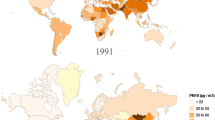Abstract
Recent epidemiological studies have demonstrated associations between residential proximity to traffic sources and adverse respiratory symptoms as the Diesel Exhaust Particulate surfaces act as a site for the concentration of thousands of organic compounds. Analysis of 24 h integrated samples of PM10 and PM2.5 collected at a kerb site in a major Indian urban community, heavily impacted by heavy commercial vehicles, showed elemental carbon concentrations higher (14.4–48.8 μg/m3) than organic carbon (1.7–9.2 μg/m3). The organic to elemental carbon ratio varied from 0.09 to 0.31. Average concentration of PM10 and PM2.5 ranged 133–492 μg/m3 and 87–160 μg/m3, respectively.


Similar content being viewed by others
References
Castro LM, Pio CA, Harrison RM, Smith DJT (1999) Carbonaceous aerosol in urban and rural European atmospheres: estimation of secondary organic carbon concentrations. Atmos Environ 33:2771–2781
Claudia M, Huffman JA, Cubison MJ, Aiken AC, Docherty KS, Kimmel JR, Ulbrich IM, Hannigan M, Jimenez JL (2009) Characterization of primary organic aerosol emissions from meat cooking, trash burning, and motor vehicles with high-resolution aerosol mass spectrometry and comparison with ambient and chamber observations. Environ Sci Technol 43:2443–2449
Dockery DW, Pope CA, Xu X, Spengler JD, Ware JH, Fay ME, Ferris BG, Speizer FE (1993) An association between air pollution and mortality in six U.S. cities. N Engl J Med 329:1753–1808
Hamilton JF, Webb PJ, Levis AC, Hopkins JR, Smith S, Davy P (2004) Partially oxidized organic components in urban aerosol using GCXGC-TOF/MS. Atmos Chem Phys 4:1279–1290
He K, Yang F, Ma Y, Zhang Q, Yao X, Chan CK, Cadle S, Mulawa P, Chan T (2001) The characteristics of PM2.5 in Beijing, China. Atmos Environ 35:4959–4970
Klaassen CD (1996) Casarett and Doull’s toxicology: the basic science of poisons. McGraw-Hill, New York
Klouda GA, Filliben JJ, Parish HJ, Chow JC, Watson JG, Cary RA (2005) Reference material (RM) 8785 air particulate matter on filter media. Aerosol Sci Tech 39:173–183
Kwangsam N, Aniket AS, Song C, David RC III (2004) Primary and secondary carbonaceous species in the atmosphere of Western Riverside County, California. Atmos Environ 38:1345–1355
Laden F, Hart JE, Eisen E, Davis M, Smith TJ, Speizer FE, Garshick E (2006) Lung cancer mortality in a retrospective cohort of drivers in the US trucking industry. Epidemiology 17:S173–S174
Mahlman JD (1997) Uncertainties in projections of human caused climate warming. Science 278:1416–1417
Schwartz J (1993) Particulate air pollution and chronic respiratory disease. Environ Res 62:7–13
Schwartz J, Dockery DW, Neas LM (1996) Is daily mortality associated specifically with fine particles? J Air Waste Manag Assoc 46:927–939
USEPA (1996) Air quality criteria for particulate matter. EPA/600/P-95/001aF-001cF. Washington, DC: U.S
VDI 2465, Part 1 (1996) Chemical analysis of elemental carbon by extraction and thermal desorption of organic carbon. ICS 13.040.20
Acknowledgments
The authors are grateful to Director NEERI for according permission to publish these findings. They are thankful to their colleagues at NEERI HQ and Zonal Labs for their involvement in sample collection.
Author information
Authors and Affiliations
Corresponding author
Rights and permissions
About this article
Cite this article
Kumar, A., Deshmukh, S.U. Elemental and Organic Carbon in Ambient Air of a Major Indian Urban Community. Bull Environ Contam Toxicol 84, 319–321 (2010). https://doi.org/10.1007/s00128-010-9938-7
Received:
Accepted:
Published:
Issue Date:
DOI: https://doi.org/10.1007/s00128-010-9938-7




